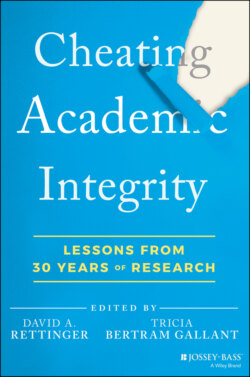Читать книгу Cheating Academic Integrity - Группа авторов - Страница 20
CURRENT AND FUTURE THREATS TO ACADEMIC INTEGRITY
ОглавлениеOne recent development that may contribute to the future recorded trends in the prevalence of academic integrity breaches is the Covid‐19 pandemic, which seriously disrupted usual higher education assessment and teaching practices. There are four main reasons to believe that the Covid‐19 pandemic may result in an increase in the prevalence of plagiarism and cheating for some years to follow. First, many higher education institutions made a rapid move away from in‐person proctored exams to various alternatives, such as unproctored take‐home exams and online exams. Clearly, proctored exams significantly reduce students’ opportunities to cheat; indeed, evidence suggests that students achieve marks 10–20 percent better in unproctored online exams, and some of this improvement may be attributable to cheating (Daffin and Jones, 2018). Second, it is reasonable to think that a rapid switch to online teaching will not have been executed with a high degree of skill or planning in all instances. Students are likely to find poorly‐delivered online courses dissatisfying, and dissatisfaction with the learning and teaching environment predicts engagement in cheating (Anderman and Won, 2019; Bretag et al., 2019). Third, the Covid‐19 pandemic is likely to have caused many students significant emotional stress, including fear for their health and the health of their loved ones, social isolation, and potential bereavement. Negative emotions, such as anxiety, increase unethical behavior per se (Kouchaki and Desai, 2015). More specifically, Tindall and Curtis (2020) reported that negative emotional experiences were related to more positive student attitudes toward plagiarism, and Birks et al. (2020) note that mental health concerns are often reported as a factor by students who have engaged in academic misconduct. Moreover, Eaton and Turner (2020) argue that steps taken to address academic integrity during the Covid‐19 pandemic, such as e‐proctoring, have unknown impacts on students’ mental well‐being. Finally, essay mills and other contract cheating services have directed advertising at students focused on “helping” students to overcome study problems attributable to the pandemic (McKie, 2020). Indeed, research emerging in 2020–2021 suggests that the prevalence of academic misconduct increased during the Covid‐19 pandemic (e.g. Lancaster and Cotarlan, 2021).
There are several reasons to think that some of the factors associated with the Covid‐19 pandemic that may increase academic misconduct prevalence will persist. Optimistic estimates initially predicted an end to the Covid‐19 pandemic in late 2021, but the emergence of variants of the virus and the need for worldwide vaccination suggests that it will persist as a public health threat for much longer than initially hoped (Charumilind et al., 2020). Numerous commentators have speculated that some substitution of face‐to‐face with online delivery, and proctored with unproctored assessments, will persist for years beyond the pandemic and may become “the new normal” (e.g. Champagne and Granja, 2021; McMurtrie, 2021). It is, therefore possible that students may develop new habits of cheating and collusion on unproctored tests that will solidify as new norms of behavior that are subsequently conveyed to other students.
Another driver of future trends in the prevalence of plagiarism and cheating is the ongoing technological tug‐of‐war between those seeking to engage in academic misconduct, or allow others to engage in academic misconduct, and those seeking to deter and detect academic misconduct. Curtis and Vardanega (2016) suggested that advances in technology that allow students to cheat and plagiarize are potentially matched by technologies that allow cheating to be detected in a process analogous to a co‐evolutionary arms race (Vermeij, 1992). The launch of Turnitin™ in 2000 and the gradual uptake of systems for automated text‐matching align historically with the downward trend in plagiarism over the past 30 years. However, an important question is, what technological changes will the future hold?
One possible battleground in the next arms race between technologies that facilitate cheating and technologies that may deter or detect cheating is artificial intelligence and machine learning. It has been reported that artificial intelligence can be used to create “passable” academic writing automatically (e.g. Abd‐Elaal et al., 2019). Automatic paraphrasing tools can potentially revise unoriginal work sufficiently to evade detection by text‐matching software (Rogerson and McCarthy, 2017). Artificial intelligence may also be used by contract cheating providers to find potential “customers” among students based, for example, on their social media posts (Amigud, 2020). By the same token, artificial intelligence and machine learning may be used to detect plagiarism, outsourcing, and machine‐written work and to verify students’ identity in online learning environments (Amigud et al., 2017). Additionally, artificial intelligence can be used to automate searches for files students inappropriately share online and have these taken down where necessary (Redden, 2021). Whether such an arms race results in a change in the prevalence of student plagiarism and cheating will depend on how fast and effectively cheating and anti‐cheating forces manage to bamboozle each other and respond in kind.
